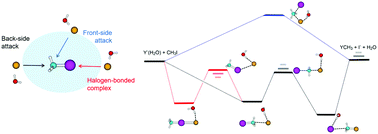Investigating the role of halogen-bonded complexes in microsolvated Y−(H2O)n + CH3I SN2 reactions†
Abstract
The dynamics of bimolecular nucleophilic substitution (SN2) reactions in the gas phase are of great interest and several new mechanisms have been observed recently by theoretical studies. Here we investigate a recent-discovered SN2 reaction mechanism, called front-side complex (FSC) or halogen-bonded complex (XC) mechanism that couples the traditional front-side attack (FSA) and back-side attack (BSA) Walden-inversion mechanism. This XC-pathway begins with a front-side attack on the leaving group, then goes through a bending transition state (XTS) that is followed by Walden-inversion, and results in a configuration inverted product. We characterized the potential energy surface of the microsolvated Y−(H2O)n=0,1,2 + CH3I SN2 reaction using the B97-1/ECP/d method, where Y = HO, F, Cl, Br, and I, and n is the number of water molecules. It is found that the XCs have a deeper well depth than the back-side attack (BSA) pre-reaction complexes for HO−/F− nucleophiles, indicating that the system can easily become trapped in the halogen-bonded complex well. The barriers of both FSA- and BSA-paths increase with incremental solvation, whereas the change of XTS depends on the type of nucleophile. When Y = HO/F, the order of the barriers is BSA < XC < FSA for n = 0–2, and the order inverts to XC < BSA < FSA for n = 1 (Y = Br/I) and n = 2 (Y = Cl/Br/I), where the latter suggests an increasing participation of the halogen-bonded complex in the SN2 reactions. Comprehensive analyses on the structure, charge distribution, and energetics of XC and XTS are provided. This work indicates that the halogen-bonded complex mechanism may be common for alkyl iodides and the information on the potential energy surface is useful in understanding the dynamics behavior of the title and analogous reactions.

- This article is part of the themed collection: 2021 PCCP HOT Articles


 Please wait while we load your content...
Please wait while we load your content...